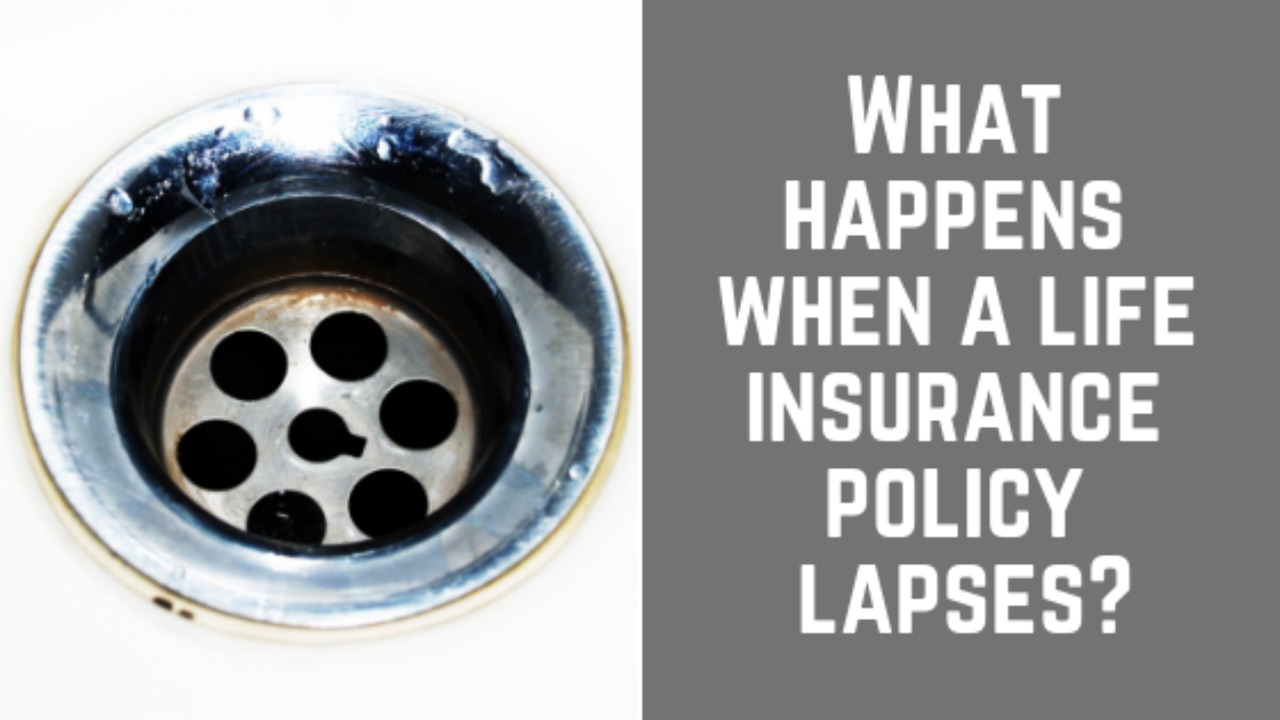

Finance
What Happens If Life Insurance Lapses?
Published: October 15, 2023
Discover what happens if your life insurance policy lapses and how it can affect your finances. Protect your future by understanding the consequences.
(Many of the links in this article redirect to a specific reviewed product. Your purchase of these products through affiliate links helps to generate commission for LiveWell, at no extra cost. Learn more)
Table of Contents
Introduction
Life insurance is a vital financial tool that provides a sense of security and protection for you and your loved ones. It offers financial support in the event of your untimely demise, ensuring that your family’s financial needs are taken care of. However, this protection is contingent upon the policy remaining active and in force.
Life insurance lapse occurs when a policyholder fails to pay the required premiums within the stipulated time frame. When a policy lapses, it means that the coverage is no longer active, and the policyholder loses the benefits associated with the policy. It is essential to understand the implications of a lapsed policy and the steps to prevent it from happening.
In this article, we will delve into what happens when a life insurance policy lapses, the reasons behind it, the consequences faced by the policyholder, and the options available to rectify the situation.
Let’s explore the world of life insurance lapse and ensure that you make informed decisions to protect your financial future.
Definition of Life Insurance Lapse
When we talk about a life insurance lapse, it refers to the termination of a life insurance policy due to the non-payment of premiums within the specified grace period. Simply put, if you fail to pay your premiums on time, your policy will lapse, and the coverage will be terminated.
The grace period is a specified timeframe, usually 30 to 60 days, during which the policyholder can make the overdue payment without facing any negative consequences. If the premiums are not paid within the grace period, the policy will officially lapse.
Once a life insurance policy lapses, the coverage ceases to exist, and the policyholder loses the benefits associated with it. It’s important to note that the lapse can occur in both term life insurance and permanent life insurance policies.
Term life insurance policies have a specified coverage period, typically ranging from 10 to 30 years. If the policyholder fails to pay the premiums during this period, the policy will lapse, and the coverage will end. On the other hand, permanent life insurance policies, such as whole life or universal life insurance, have a lifetime coverage duration. However, these policies also have premium requirements, and if the policyholder fails to meet them, the policy may lapse.
It is crucial to understand that a life insurance lapse is a serious matter and can have significant implications for both the policyholder and their beneficiaries. Let’s explore the reasons behind life insurance lapse and the potential consequences that may arise.
Reasons for Life Insurance Lapse
Several factors can contribute to the lapse of a life insurance policy. Understanding these reasons can help you avoid the unfortunate situation and ensure that your coverage remains active. Here are some common reasons for life insurance lapse:
- Non-payment of premiums: The most common reason for a policy lapse is the failure to pay the premiums on time. People may forget, face financial difficulties, or simply neglect to make the required payments.
- Insufficient funds: If there are insufficient funds in the policyholder’s bank account or the payment method fails due to expired credit cards, the premiums may not be successfully processed, leading to a policy lapse.
- Change in financial situation: A change in financial circumstances, such as job loss, divorce, or medical expenses, can make it challenging to afford the premium payments. This can result in the policyholder discontinuing the payments, leading to a lapse.
- Miscommunication: Sometimes, miscommunication between the insurance company and the policyholder may lead to a lapse. This can occur if the policyholder does not receive the premium notices or if there is a misunderstanding regarding the payment schedule.
- Policyholder’s health: In the case of certain types of life insurance, the policy may have a requirement for the policyholder to meet certain health standards. If the policyholder’s health deteriorates and they no longer meet these standards, the insurance company may increase the premiums or even cancel the policy.
It is important to be aware of these reasons and take appropriate measures to ensure that your life insurance policy remains in force. Now, let’s delve into the consequences of a life insurance lapse.
Consequences of Life Insurance Lapse
Allowing a life insurance policy to lapse can have significant repercussions for the policyholder and their beneficiaries. Understanding the consequences of a policy lapse is crucial to grasp the importance of maintaining active coverage. Here are some potential consequences of a life insurance lapse:
- Loss of coverage: The primary consequence of a lapse is the loss of life insurance coverage. This means that if the policyholder were to pass away after the policy lapses, their beneficiaries would not receive the death benefit specified in the policy.
- Inability to reinstate the policy: Once a policy lapses, it can be challenging to reinstate it. The insurance company may require the policyholder to go through a reinstatement process, which may involve additional paperwork, medical examinations, and possible premium increases.
- Loss of accumulated cash value: If the lapsed policy is a permanent life insurance policy with a cash value component, the policyholder may lose any accumulated cash value. This can be a significant financial loss, as the cash value can serve as a source of funds for emergencies or future expenses.
- Increased premiums: If the policyholder decides to reinstate the policy after a lapse, the insurance company may require higher premium payments. This is because the policyholder is considered a higher risk due to the previous lapse, resulting in increased premiums to compensate for the perceived risk.
- Limited options: In some cases, a lapsed policy may limit the policyholder’s options for obtaining new life insurance coverage. If the policyholder’s health has deteriorated since the lapse, it may be more difficult or expensive to secure a new policy.
It is important to remember that the consequences of a life insurance lapse can vary depending on the specific policy and insurance company. It is always advisable to review your policy documents and consult with your insurance provider to fully understand the implications of a potential lapse.
Now that we have explored the consequences, let’s move on to understanding the impact of a life insurance lapse on the policy benefits.
Impact on Policy Benefits
When a life insurance policy lapses, the impact on the policy benefits can be significant. It is essential to understand how a lapse can affect the benefits that you and your beneficiaries may receive. Here are some key points to consider:
- Loss of death benefit: The most significant impact of a policy lapse is the loss of the death benefit. If the policyholder passes away after the policy has lapsed, their beneficiaries will not receive the payout specified in the policy. This can leave dependents and loved ones financially vulnerable in a time of need.
- Loss of cash value: If the lapsed policy is a permanent life insurance policy with a cash value component, the policyholder may lose any accumulated cash value. This can have financial implications, as the cash value can serve as a source of funds for emergencies, education expenses, or even supplement retirement income.
- Reduced loan availability: In permanent life insurance policies, the policyholder can typically take out a loan against the cash value of the policy. However, a lapsed policy may limit or eliminate the ability to access this loan feature. This can restrict the policyholder’s options for borrowing against the policy in the future.
- Beneficiary disputes: A policy lapse can lead to potential disputes among beneficiaries. If a policy lapses and there are multiple beneficiaries listed, conflicts may arise regarding the division of the death benefit, particularly if the policyholder did not update their beneficiaries after the lapse.
It is important to note that the impact on policy benefits can vary depending on the specific terms and conditions of the policy. Some policies may offer a grace period or options for reinstatement, which can mitigate the loss of benefits if acted upon promptly.
Now that we understand the impact of a policy lapse on the benefits, let’s explore the options available to reinstate a lapsed life insurance policy.
Reinstating a Lapsed Life Insurance Policy
If your life insurance policy has lapsed, it may still be possible to reinstate it and regain coverage. Reinstating a lapsed policy requires taking specific steps outlined by the insurance company. While the process can vary depending on the policy and insurance provider, here are some general steps to reinstate a lapsed life insurance policy:
- Contact your insurance provider: As soon as you realize that your policy has lapsed, contact your insurance provider to initiate the reinstatement process. They will guide you through the necessary steps and provide you with the required forms and information.
- Pay the outstanding premiums: To reinstate your policy, you will typically need to pay any outstanding premiums. This may include the missed premium payments and any applicable late fees or interest charges. Make sure to inquire about the total amount due and the acceptable payment methods.
- Provide updated information: Depending on the duration of the lapse, your insurance provider may require updated information, such as your current health status or financial situation. You may need to complete new applications, undergo medical examinations, or provide any necessary documentation.
- Review the reinstatement terms: Before proceeding with the reinstatement, carefully review the terms and conditions outlined by your insurance provider. Take note of any changes in premiums, coverage, or policy benefits that may occur due to the lapse and reinstatement process.
- Follow the timeline: It is crucial to adhere to the timeline provided by your insurance provider for the reinstatement process. Pay attention to the deadlines for completing paperwork, making payments, or submitting any required documentation.
Keep in mind that the reinstatement process may also depend on the specific rules and regulations of your insurance provider. It is advisable to consult with them directly to understand the exact requirements and options available for reinstating your lapsed life insurance policy.
In some cases, reinstatement may not be possible or may not be the best option for your situation. In such instances, there are alternative options to consider, which we will explore in the next section.
Alternatives to Reinstatement
If reinstating a lapsed life insurance policy is not feasible or not the best option for your circumstances, there are alternatives to consider. These alternatives can help you maintain some level of financial protection for your loved ones. Here are a few options to explore:
- Purchasing a new policy: If reinstating your lapsed policy is not viable, you can explore purchasing a new life insurance policy. However, it’s important to keep in mind that obtaining a new policy may be more challenging and costly due to factors such as age or changes in health since the last policy was in force.
- Convert term to permanent insurance: If your lapsed policy was a term life insurance policy, check if there is an option to convert it to a permanent life insurance policy. This conversion allows you to maintain coverage without having to go through the underwriting process. However, there may be specific timelines or conditions associated with the conversion option.
- Explore other life insurance alternatives: In addition to traditional life insurance policies, there are alternative options to consider, such as no-exam life insurance or guaranteed issue life insurance. These policies may have less stringent underwriting requirements, making them more accessible even after a lapse.
- Consider group life insurance: If you have access to group life insurance through your employer or a professional organization, consider enrolling in or increasing your coverage. Group life insurance typically does not require medical underwriting, making it an attractive option for those who may have difficulty obtaining individual policies.
- Review other financial resources: If obtaining a new policy is not feasible, it may be necessary to explore alternative financial resources to ensure your loved ones’ protection. This may involve savings accounts, investments, or other insurance products like accidental death and dismemberment insurance.
It is crucial to carefully evaluate these alternatives and consider their long-term implications. Compare costs, coverage limits, and potential exclusions before making a decision. Consult with a financial advisor or insurance professional to ensure that you make an informed choice that aligns with your financial goals and needs.
Now that we have explored alternatives to reinstatement, let’s discuss some important factors to consider before letting your life insurance policy lapse.
Factors to Consider Before Letting Life Insurance Lapse
Before allowing your life insurance policy to lapse, it is crucial to carefully evaluate the following factors. These considerations will help you make an informed decision based on your current financial situation, future needs, and potential consequences:
- Financial obligations: Consider your current financial obligations and responsibilities. Evaluate whether you have adequate savings or other sources of income to cover your family’s financial needs in the event of your passing. Consider factors such as mortgage payments, outstanding debts, education expenses, and day-to-day living costs.
- Dependency of loved ones: Assess the dependency of your loved ones on your financial support. Consider the impact your absence would have on their financial stability, particularly if you are the primary or sole income earner. Evaluate if there are other means of support available to them in the event of your passing.
- Health and insurability: Reflect on your current health and any potential changes in your insurability. If your health has deteriorated since you obtained the policy, it may be more challenging and expensive to secure new life insurance coverage in the future. Assess whether maintaining the current policy is the most viable option for your long-term financial protection.
- Prioritizing coverage: Consider whether life insurance coverage is a priority for you and your family. Assess whether the premium payments are manageable within your budget or if adjustments can be made to accommodate the premiums. Weigh the importance of financial protection against other financial goals and obligations.
- Policy surrender value: If your policy has accumulated cash value, evaluate the surrender value of the policy. If you decide to let the policy lapse, you may be entitled to a portion of the cash value. However, surrendering the policy may have tax implications, so consult with a financial advisor or tax professional before making a decision.
Taking these factors into account will help determine the best course of action regarding your life insurance policy. Remember, a conscientious evaluation of your financial situation and goals is crucial to make an informed decision that adequately protects your loved ones.
As we conclude, it is vital to maintain open communication with your insurance provider to stay informed about premium payments, policy updates, and any changes that may impact your coverage. Regularly reviewing your policy and assessing your financial needs will help ensure that your life insurance coverage remains effective and meaningful.
Conclusion
Life insurance is an essential tool for providing financial protection and peace of mind to you and your loved ones. It is important to understand the implications of a life insurance policy lapse and take proactive steps to prevent it from happening. A lapsed policy can lead to the loss of coverage, benefits, and potential hardships for your beneficiaries.
In this article, we discussed the definition of a life insurance lapse and explored the reasons behind it. We also examined the consequences of a policy lapse, including the impact on benefits and the challenges of reinstating a lapsed policy.
Reinstating a lapsed life insurance policy requires contacting your insurance provider, paying the outstanding premiums, and potentially providing updated information. However, if reinstatement is not possible or not the best option for your situation, there are alternatives to consider, such as purchasing a new policy or exploring other insurance options.
Before letting your life insurance policy lapse, review factors such as your financial obligations, the dependency of your loved ones, your current health status, and the surrender value of the policy. These considerations will help you make an informed decision that aligns with your financial goals and provides the necessary protection for your family.
Lastly, regular communication with your insurance provider, reviewing your policy periodically, and assessing your financial needs will help ensure that your life insurance coverage remains active and meaningful.
Remember, life insurance is a valuable tool to safeguard the financial well-being of your loved ones. By understanding the repercussions of a policy lapse and taking proactive measures, you can ensure the ongoing protection and security that life insurance provides.














